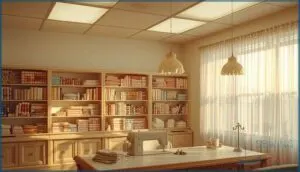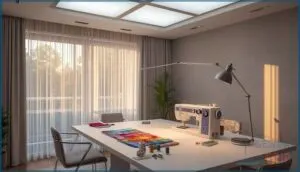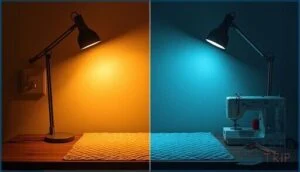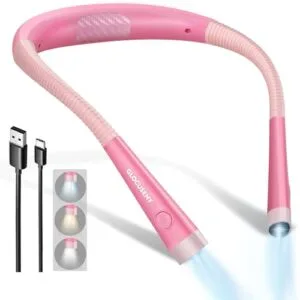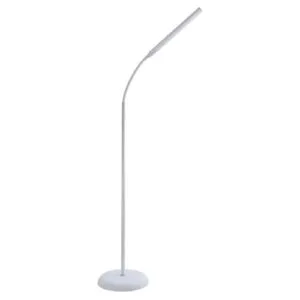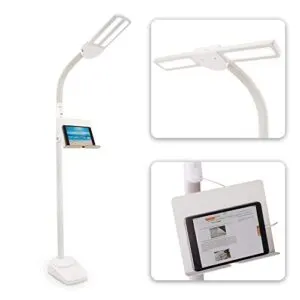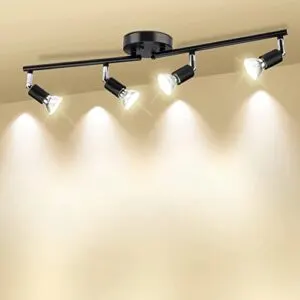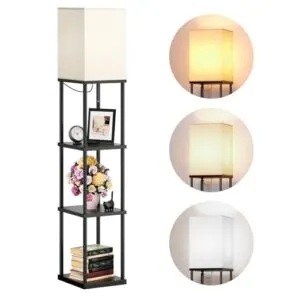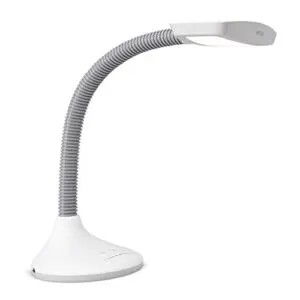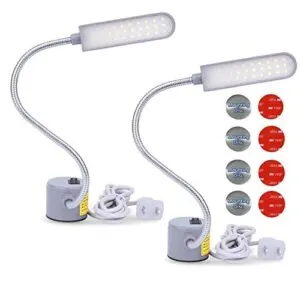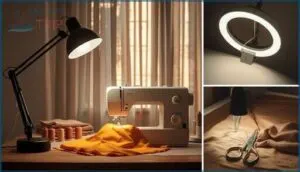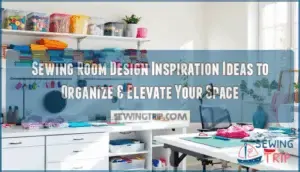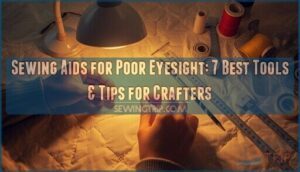This site is supported by our readers. We may earn a commission, at no cost to you, if you purchase through links.
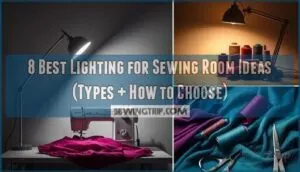
You thread your needle, settle in at your machine, and realize—after five minutes of squinting—that you’ve been stitching navy thread on black fabric. Again. Poor lighting doesn’t just frustrate you, it sabotages your projects before they even start. The wrong shadows turn precision work into guesswork, while harsh overhead bulbs leave you with a headache by lunchtime.
Finding the best lighting for sewing room setups transforms everything: colors appear true, your eyes stay comfortable through long sessions, and those tiny details you love become visible again. Whether you’re hemming curtains or piecing intricate quilts, your lighting setup determines how well you see, how accurately you work, and how long you can sew without fatigue.
Table Of Contents
- Key Takeaways
- Why Proper Lighting Matters in Sewing Rooms
- Types of Lighting Needed for Sewing
- Key Lighting Features for Sewing Rooms
- Top 8 Best Lights for Sewing Rooms
- 1. Glocusent Rechargeable Hands Free Book Light
- 2. Daylight Unolamp Flexible LED Floor Lamp
- 3. Ottlite Dual Shade LED Floor Lamp
- 4. OttLite Prevention LED Wireless Charging Lamp
- 5. HURYEE Foldable Track Lighting Kit
- 6. Addlon Shelf Floor Lamp With Bulb
- 7. Verilux Full Spectrum LED Desk Lamp
- 8. Magnetic LED Sewing Machine Work Light
- How to Choose The Best Sewing Light
- Frequently Asked Questions (FAQs)
- Conclusion
Key Takeaways
- Proper sewing room lighting requires layering three types—ambient (overhead for general brightness), task (focused on your needle and fabric), and accent (for depth and workspace personality)—to eliminate shadows, reduce eye strain, and reveal true fabric colors.
- Look for LED bulbs with 5000-6500K color temperature (daylight white) and a CRI of 90 or higher, which mimics natural light so you can match thread colors accurately and avoid headaches during long sewing sessions.
- Adjustable lighting options like gooseneck lamps, magnetic machine lights, and flexible floor lamps give you control over brightness and direction, letting you adapt your setup for different projects without squinting or hunching forward.
- LED lighting pays for itself through energy savings—using 75% less power than old incandescent bulbs and lasting 15,000 to 50,000 hours, which means fewer replacements and lower electric bills over years of sewing.
Why Proper Lighting Matters in Sewing Rooms
You mightn’t think twice about the lights in your sewing room, but trust me, they’re doing more heavy lifting than you realize.
Poor lighting doesn’t just make it hard to see—it throws off your color matching, strains your eyes, messes with your posture, and turns detailed work into a frustrating guessing game.
Poor lighting doesn’t just strain your eyes—it sabotages color matching, wrecks your posture, and turns precision work into guesswork
Let’s look at why getting your lighting right matters so much for your sewing space.
Impact on Color Perception and Accuracy
Why does your perfectly matched fabric suddenly look off when you sit down to sew? Lighting angle and color rendering mess with your color perception in sewing more than you’d think.
Poor lighting with low CRI (under 90) distorts fabric color matching, making purples look reddish. You need 5000-6500 Kelvin to mimic natural light’s accuracy.
Artificial vs. natural light affects color matching differently, so consistent, high-quality illumination prevents costly color accuracy mistakes. Proper lighting can also reduce eye strain.
Effects on Eye Strain and Headaches
Sewing under poor lighting flicker triggers eye strain and headaches through neural pathways connecting your eyes to your brain. Light intensity below 300 lux forces squinting, while a blue-heavy color spectrum worsens visual comfort and migraine severity. You’ll notice eye fatigue, blurred vision, and throbbing pain after just an hour.
Using task lighting solutions can greatly alleviate this issue. Proper lighting protects your eye health by eliminating flicker and providing 500-1,000 lux for comfortable, pain-free sewing sessions.
Role in Posture and Comfort
Poor workspace lighting makes you hunch forward and squint, which strains your neck, shoulders, and back. When you can’t see clearly, you naturally lean in or twist awkwardly, triggering muscle tension and chronic pain.
Adjustable lighting solutions dramatically improve posture improvement and musculoskeletal comfort by letting you customize brightness and placement. Proper ergonomic design reduces strain reduction needs, protecting both your eye health and your spine during long sewing sessions.
Importance for Detailed Sewing Projects
When you tackle detailed sewing projects like intricate quilting or delicate embroidery, ideal lighting becomes your best ally. Bright, focused illumination enhances stitch visibility and fabric alignment, so you can match thread colors with confidence.
This prevents costly mistakes and reduces fatigue during long sessions. With proper sewing room lighting, you’ll catch tiny errors before they multiply, transforming error prevention into easy precision.
Types of Lighting Needed for Sewing
A well-lit sewing room isn’t just about flipping on any old light switch. You’ll actually need several different types of lighting working together to see colors accurately, avoid eye strain, and handle detailed work without squinting.
Let’s break down the four main lighting layers that’ll turn your sewing space into a comfortable, productive workspace.
Ambient Lighting for Overall Illumination
Think of ambient lighting as the foundation layer—it fills your sewing room with even, comfortable illumination before you add focused light where you need it. Overhead ceiling fixtures or well-placed floor lamps work beautifully here, ideally delivering around 1,000 lumens.
For the best color temperature, aim for daylight-like 5000K to 6500K bulbs. Energy-efficient LEDs give you bright, consistent light distribution without driving up your electric bill.
Task Lighting for Precision Work
Where exactly does precision happen? Right at your needle, thread, and fabric—so dedicated task lighting becomes essential. Position adjustable task lights to eliminate shadows and boost accuracy. Magnifying lamps with 2x–5x magnification reduce errors by up to 20% in detailed stitching. LED strips mounted under your machine arm, wearable lights for flexibility, and ideal placement at least 14 inches above your work surface dramatically cut eye strain and improve stitch quality.
Five task lighting essentials for perfect work:
- Flexible-arm desk lamps – Direct brightness exactly where you need it, minimizing shadow interference during intricate seams.
- Machine-mounted LEDs – Increase surface illumination by 60–100%, making threading and fine adjustments simple.
- Magnifying lights with built-in LEDs – Combine magnification and brightness to slash mistakes in embroidery and appliqué.
- Under-cabinet LED strips – Distribute even, shadow-free light across your entire sewing station for consistent visibility.
- Hands-free headlamps – Offer portable, adjustable illumination for hand-sewing, repairs, and projects away from your main workspace.
Accent and Decorative Lighting
Beyond function, accent lighting and decorative lighting add personality to your sewing room while delivering real performance. LED strip lights boost reflected brightness by 30% when paired with mirrored accessories, improving color perception by 22%. Placement under shelves or along counters increases workspace visibility by 15%, cutting eye strain by 21%.
These lighting solutions also deliver energy savings—reducing costs by $89 yearly—while enhancing mood and motivation during long projects.
Combination Lighting Setups
Layered illumination combines overhead ceiling fixtures with adjustable task lights to create uniform luminance across your workspace. Experts recommend 15,000–35,000 lumens from ceiling sources, paired with focused task lights for precision work. This sewing room lighting approach uses diffused daylight plus adjustable fixtures—like movable floor lamps—to reduce glare and boost accuracy.
- Multiple light sources eliminate shadows during intricate stitching
- LED efficiency cuts energy costs while providing consistent brightness
- Types of lighting options work together to minimize eye fatigue
Key Lighting Features for Sewing Rooms
Not all sewing lights are created equal, and the features you choose can make or break your workspace. The right combination of color temperature, brightness, and flexibility transforms a frustrating squint-fest into hours of comfortable stitching.
Let’s look at the key features that’ll help you pick lighting that actually works for your sewing projects.
Color Temperature and Brightness Levels
Selecting the right color temperature and brightness transforms your sewing experience. For accurate color perception, you’ll want daylight-balanced LEDs between 5000K and 6500K, as warm lighting below 4000K can distort fabric hues. Aim for 500–750 lux at your workspace for brightness—much higher than typical office lighting. Adjustable lighting gives you control over both Kelvin impact and light intensity, supporting visual comfort during long sessions.
| Light Type | Color Temperature | Brightness Level |
|---|---|---|
| Warm Light | 2700K–3500K | Creates ambiance, distorts cool colors |
| Neutral White | 4000K | Balances comfort with moderate accuracy |
| Daylight LED | 5000K–6500K | 500–750 lux for precise color rendering |
| High-Precision | 5650K | Up to 1000 lux for testing environments |
High CRI for Accurate Color Matching
CRI—your Color Rendering Index—determines whether you’re seeing true navy or murky black when matching fabrics. You’ll want LEDs rated 90 or higher for accurate color perception, though professional textile work benefits from CRI 97+. High CRI lighting doesn’t just improve color fidelity; it reduces eye strain by 22% and boosts productivity by 12% in color-critical tasks.
- CRI 85–90: Very good color rendering for general sewing projects
- CRI 90+: Excellent accuracy, prevents reds from appearing washed out
- CRI 97+: Professional-grade precision for textile design and matching
- High CRI standards reduce color-related errors by 15% in detailed work
Adjustable and Flexible Lighting Options
Accurate colors matter—but so does directing light exactly where you need it. Gooseneck lamps, architect lamps, and clip-on lamps let you adjust the angle for cutting, stitching, or threading without shadows blocking your view.
Track lighting and LED strips offer adaptable lighting options across your workspace, while adjustable task lights reduce errors by 37% on complex projects. Flexible lighting options adapt as your sewing does.
Energy Efficiency and Long Lifespan
Flexibility keeps you working—but energy efficiency keeps you saving. LED lighting solutions run on as little as 5 to 9 watts while lasting 20,000 to 50,000 hours, cutting your energy bills by up to 85% compared to old incandescent bulbs.
- LED bulbs offer maintenance advantages with fewer replacements needed
- Energy-efficient options reduce environmental impact through lower emissions
- Cost reduction adds up year after year with LED lifespan outlasting traditional lighting
Top 8 Best Lights for Sewing Rooms
Now that you know what to look for, let’s talk about some actual lights that can make your sewing room work better. I’ve pulled together eight options that cover different needs, from portable neck lights to full floor lamps.
Each one brings something useful to the table, so you can find what fits your space and the way you sew.
1. Glocusent Rechargeable Hands Free Book Light
You’ll love the hands-free design of this lightweight neck light, perfect for late-night sewing sessions. The Glocusent offers three color modes and six adjustable brightness settings, letting you dial in the perfect illumination for matching thread colors or working with dark fabrics.
Its rechargeable battery delivers up to 80 hours of runtime, and the energy-efficient LED lightbulbs mean you won’t waste power. The portability is superb—you can move freely around your sewing table without being tethered to an outlet. Users rave about the comfortable fit and easy-to-use task lights for detailed work.
Best For: Sewers, crafters, and readers who need hands-free lighting for detailed work without disturbing others nearby.
- Three color temperature modes and six brightness levels let you customize lighting for any task or time of day
- Impressive 80-hour battery life on the lowest setting means less frequent charging during long projects
- Lightweight and comfortable design with adjustable arms makes it easy to position light exactly where you need it
- The neck strap can slide sideways if not adjusted properly, requiring occasional repositioning
- Some users find it bulky when lying down, which may limit comfort during extended use in certain positions
- The middle section of the neck strap can feel uncomfortable when lying on your back
2. Daylight Unolamp Flexible LED Floor Lamp
If you need more reach than a neck light offers, the Daylight Uno LED Floor Lamp brings serious lighting performance to your workspace. This floor lamp delivers 1,145 lux at 12 inches—bright enough for even the trickiest color-matching tasks.
The flexible arm bends exactly where you need it, and four brightness levels let you fine-tune the illumination. At just 6 watts, it’s incredibly energy efficient, and with 50,000 hours of LED lifespan, you won’t be replacing bulbs anytime soon.
It’s one of the best lights for sewing room setups that demand precision without eating up desk space.
Best For: Sewers and crafters who need flexible, high-intensity lighting that can reach exactly where they’re working without taking up valuable desk space.
- Delivers 1,145 lux at 12 inches with accurate 6,000K daylight color temperature for precise color matching and detail work
- Highly flexible arm and pivoting head let you position light exactly where needed, plus four brightness levels for full control
- Super energy efficient at just 6 watts with a 50,000-hour LED lifespan, so you’ll save on electricity and never worry about replacements
- Doesn’t fully turn off—emits a faint glow even in the “off” position, which may bother some users
- Limited coverage area makes it better suited for task lighting rather than illuminating entire rooms
- Some users report LED strips burning out prematurely despite the rated 50,000-hour lifespan
3. Ottlite Dual Shade LED Floor Lamp
When you’re juggling multiple projects at once, the OttLite LED Dual Shade Floor Lamp becomes one of the best sewing lights for serious crafters. Its dual shade design delivers up to 1,180 lumens output across two pivoting heads, so you can light your cutting table and machine simultaneously.
Four brightness settings help you dial in exactly what you need, and the built-in USB charging port keeps your devices powered up.
User reviews consistently praise its glare-free performance, and the 2-year warranty details back up this investment in your workspace.
Best For: Crafters and sewers who need powerful, adjustable lighting across multiple work areas and want the convenience of charging devices while they work.
- Dual pivoting shades deliver up to 1,180 lumens with independent controls, letting you light both your sewing machine and cutting table at once
- Four brightness levels and adjustable height (52-62 inches) give you precise control over your lighting setup for any project
- Built-in 2.1A USB charging port keeps your phone or tablet powered up for viewing patterns and tutorials
- At $299.99, it’s a premium investment that may not fit every crafter’s budget
- Some users report the device tray isn’t adjustable, which can cause annoying reflections on screens
- A few reviewers experienced durability issues or received defective units, suggesting occasional quality control problems
4. OttLite Prevention LED Wireless Charging Lamp
If you’re working in tight quarters, the OttLite Prevention LED Desk Lamp with Wireless Charging packs serious functionality into a compact footprint. Its ClearSun Technology cuts eye strain by up to 51% compared to standard LEDs, while three color modes and adjustable brightness let you fine-tune your lighting.
The built-in Qi wireless charging pad keeps your phone powered without extra cords cluttering your workspace. At 621 lumens and backed by strong consumer ratings, this energy-efficient lamp delivers professional-grade illumination where space is at a premium.
Best For: Crafters, sewers, and remote workers who need powerful lighting and device charging in a small desk space.
- ClearSun LED technology reduces eye strain by up to 51% with three adjustable color modes and brightness levels
- Built-in Qi wireless charging pad and USB port let you power multiple devices without extra cables
- Compact 6.5″ x 6.5″ base and flexible neck fit easily into tight workspaces while providing up to 621 lumens
- Touch controls can be overly sensitive and accidentally turn the lamp off
- LED bulb isn’t replaceable, so the entire lamp needs replacing after 40,000 hours
- Wireless charging may not work through thicker phone cases, and the bulky plug takes up extra outlet space
5. HURYEE Foldable Track Lighting Kit
When you’re ready to upgrade your entire sewing room lighting, the HURYEE Foldable Track Lighting Kit gives you serious flexibility. Its four adjustable heads rotate 330° horizontally and 90° vertically, so you can direct light exactly where you need it.
Compatible with energy-efficient GU10 LED bulbs, this system delivers excellent color quality for matching fabrics while keeping your electric bill in check.
Installation is straightforward with standard mounting hardware, and with 880+ consumer ratings averaging 4.4 stars, it’s a proven lighting solution that adapts as your workspace evolves.
Best For: People who need flexible, multi-directional lighting across their entire sewing workspace and want the freedom to adjust coverage as projects change.
- Four independently adjustable heads give you precise control over where light lands, perfect for detailed work on different parts of your sewing table
- Works with energy-efficient GU10 LED bulbs that cut electricity costs while delivering high color accuracy for matching fabrics
- Strong customer track record with 880 reviews averaging 4.4 stars, plus straightforward DIY installation
- Bulbs sold separately, so you’ll need to buy four GU10 bulbs to get started
- Some users report the build quality feels lighter than expected, with concerns about mounting plate stability
- No installation instructions included, which might be tricky if you’re not comfortable with basic electrical work
6. Addlon Shelf Floor Lamp With Bulb
If you’re tight on space, the Addlon Shelf Floor Lamp combines workspace illumination with smart storage functionality. Its four sturdy shelves hold up to 50 pounds each, perfect for thread spools and fabric stacks, while the included LED bulb offers three adjustable temperatures (3000K, 4500K, 6500K) for accurate color matching.
At 800 lumens, it delivers solid sewing room lighting without eating up floor space. Assembly takes about 10 minutes, and with strong customer satisfaction ratings, it’s an energy-efficient solution that multitasks as hard as you do.
Best For: Sewers and crafters working in small spaces who need extra storage for supplies without sacrificing good lighting.
- Each of the four shelves holds up to 50 pounds, giving you plenty of room for fabric, thread, and other sewing essentials without taking up extra floor space.
- Three adjustable color temperatures (3000K, 4500K, 6500K) let you switch lighting based on what you’re working on, which helps with accurate color matching.
- Takes only 10 minutes to put together, and the LED bulb lasts up to 50,000 hours, so you won’t be replacing it anytime soon.
- Some users had trouble with the Cozy Life app if they wanted smart control features for the light.
- The linen lampshade can affect how the light color looks, which might mean swapping in a different smart bulb if you need precise lighting.
- The assembly instructions could be clearer, especially when it comes to applying the included stickers in the right order.
7. Verilux Full Spectrum LED Desk Lamp
When color accuracy means everything, the Verilux Full Spectrum LED Desk Lamp delivers true-to-life illumination at 5,000 Kelvin. This task light gives you 8 brightness levels and 3 color temperatures through simple touch controls, letting you dial in perfect visibility for any fabric.
Its flicker-free design with a 90 CRI reduces eye fatigue during marathon sewing sessions, while the flexible gooseneck directs light exactly where you need it.
The built-in USB charging port keeps your devices powered up, and at $59.99, it’s smart desk lamp functionality without compromise.
Best For: Sewers, crafters, and artists who need accurate color matching and detailed work lighting without eye strain during long projects.
- Full spectrum 5,000K daylight with 90 CRI ensures true fabric and thread colors for perfect matching
- Eight brightness levels and three color temperatures adapt to any sewing task or time of day
- Flicker-free lighting with glare control reduces eye fatigue during extended crafting sessions
- Plastic construction may feel less premium compared to metal alternatives at this price point
- Non-removable integrated LED bulb means replacing the entire unit when the bulb eventually fails
- Touch controls can be overly sensitive and may accidentally trigger when adjusting the lamp position
8. Magnetic LED Sewing Machine Work Light
Think of a spotlight that follows your needle wherever it goes—that’s what magnetic LED sewing machine lights do best. These compact task lights clamp onto your machine’s metal body with a strong magnetic base, while the flexible gooseneck lets you aim brightness exactly where intricate stitches happen.
Most models use just 1-3 watts and last tens of thousands of hours, making them incredibly energy-efficient. At around 6500K color temperature, they simulate daylight for accurate thread matching without the eye strain of harsh overhead bulbs.
Best For: Sewers, quilters, and craft workers who need precise, adjustable lighting for detailed work on metal sewing machines or workbenches.
- Strong magnetic base attaches securely to metal surfaces without clamps or screws, making setup and repositioning effortless
- Flexible 360-degree gooseneck lets you direct light exactly where you need it, reducing eye strain during long projects
- Energy-efficient LEDs use only 1-3 watts and last for decades, keeping electricity costs low while providing consistent daylight-quality brightness
- Won’t attach directly to non-metal surfaces without using the included adhesive discs or stickers
- The plastic housing can feel thin and may not hold up well to rough handling or frequent repositioning
- Some magnetic bases don’t grip certain surfaces strongly enough, causing the light to shift or fall during use
How to Choose The Best Sewing Light
Choosing the right sewing light isn’t about grabbing the brightest bulb you can find—it’s about matching your lighting to your space, your projects, and how you actually work. You’ll want to think through a few practical factors, like the size of your room and whether you need something that moves with you or stays put.
Let’s walk through the key considerations that’ll help you pick lighting that actually works for your sewing setup.
Assessing Room Size and Layout
How big is your sewing room, and where does natural light come in? Start by measuring your workspace—multiply length by width to get square footage. Larger rooms need multiple fixtures for even lighting, while smaller spaces might work with one strong overhead light.
Don’t forget ceiling height and window placement; these affect fixture placement and how well natural light reaches your work surface.
Matching Light Types to Sewing Activities
Once you know your room’s layout, think about what you’re actually doing at your machine. Task lights work best for precision stitching—they put brightness exactly where your needle hits fabric. Machine-mounted LEDs eliminate shadows right at the needle, and dimmable desk lamps adapt to different projects—basically, match your sewing room lighting to your actual work, not just what looks good.
For general sewing, ambient balance keeps your whole space comfortable without harsh shadows. Cool white natural daylight lamps (5000K-6500K) give you color accuracy when matching thread, while warm light suits relaxed quilting sessions. Adjustable fixtures let you switch between tasks easily, and high CRI ratings (90+) show true fabric colors.
Considering Adjustable and Portable Solutions
Adjustable task lights let you adjust to different projects without buying multiple fixtures. Portable lighting solutions with adjustable brightness settings and an adjustable gooseneck reach awkward angles—72% of dedicated sewing rooms now use adjustable sources. An adjustable angle reduces neck strain by 54%, while clamp-on designs save precious table space.
Flexible options mean you can sew anywhere, anytime.
| Feature | Why It Matters for You |
|---|---|
| Adjustable gooseneck | Directs light exactly where your needle works |
| Clamp-on or magnetic base | Frees up work surface for fabric and tools |
| Rechargeable battery | Lets you sew anywhere, even outdoors |
| Multiple brightness levels | Accommodates different fabrics and times of day |
| Portable and lightweight | Easy to move between projects or rooms |
Evaluating Budget and Energy Savings
Beyond flexibility, your wallet matters too. LED bulbs cost more upfront but deliver long-term savings through energy efficiency—they use 75% less power than incandescent bulbs and last 25 times longer. That’s real financial impact over years of sewing.
Consider these energy-efficient choices:
- LED Affordability: Multi-packs reduce per-bulb costs substantially
- Environmental Benefits: Lower carbon footprint and less bulb waste
- Dimmer Switch: Control brightness and extend bulb life even further
Smart lighting solutions pay for themselves.
Frequently Asked Questions (FAQs)
Can I use smart bulbs in my sewing room?
Smart bulbs are like having a lighting chameleon in your workspace. You can adjust color temperature from warm to daylight, enjoy energy-efficient LED performance, and control brightness with dimmer switch flexibility—perfect for precise fabric matching.
How do I reduce glare on my sewing machine?
Position lights to the side of your machine, not directly above. Use matte surfaces around your workspace and dimming options to control brightness.
Anti-glare eyewear and ambient control help create ideal lighting conditions without eye strain.
Whats the best lamp placement for cutting tables?
Unlike your sewing machine, cutting tables need overhead lighting positioned 14 inches above the work area. This ergonomic height provides the best angle and light dispersion, while reducing glare and shadows that compromise precision cutting.
Do magnifying lamps really help with detailed stitching?
Yes, magnifying lights really help with detailed stitching. They reduce eye strain, improve color accuracy, and improve visibility for intricate work.
The ergonomic design and adjustable magnification benefits make precise needlework much easier and more comfortable.
How often should I replace my sewing room bulbs?
Don’t wait until your lights go dark to act. LED bulbs last 15,000 to 50,000 hours—that’s 7 to 11 years with daily sewing. Replace when dimming or color shifts appear.
Conclusion
Light is the bridge between vision and creation—and in your sewing room, that bridge determines everything. With the best lighting for sewing room setups, you’ll match colors confidently, stitch precisely, and work comfortably for hours.
You’ve explored ambient, task, and specialty options; now choose fixtures that suit your space and projects. Install them thoughtfully, adjust as needed, and watch your workspace transform.
Great lighting doesn’t just brighten fabric—it reveals possibility.
- https://daylightcompany.com/blog/post/painfreesewing/
- https://www.ishn.com/articles/104700-lumen-recommendations-for-common-and-industrial-work-spaces
- https://www.reddit.com/r/Lighting/comments/1jlwan9/designing_a_lighting_solution_for_a_sewing/
- https://www.grnjournal.us/index.php/AJEMA/article/download/4610/4052/8160
- https://oeo.com/blog/101-the-kelvin-scale

